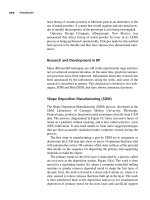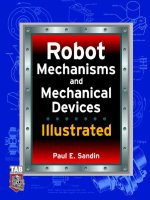Tài liệu Robot Mechanisms and Mechanical Devices Illustrated P1 pdf
Bạn đang xem bản rút gọn của tài liệu. Xem và tải ngay bản đầy đủ của tài liệu tại đây (547.81 KB, 30 trang )
Robot Mechanisms
and Mechanical
Devices Illustrated
Paul E. Sandin
McGraw-Hill
New York | Chicago | San Francisco | Lisbon | London | Madrid
Mexico City | Milan | New Delhi | San Juan | Seoul | Singapore | Sydney | Toronto
Copyright © 2003 by The McGraw-Hill Companies, Inc. All rights reserved. Manufactured in the United States of America.
Except as permitted under the United States Copyright Act of 1976, no part of this publication may be reproduced or distrib-
uted in any form or by any means, or stored in a database or retrieval system, without the prior written permission of the
publisher.
0-07-142928-X
The material in this eBook also appears in the print version of this title: 0-07-141200-X
All trademarks are trademarks of their respective owners. Rather than put a trademark symbol after every occurrence of a
trademarked name, we use names in an editorial fashion only, and to the benefit of the trademark owner, with no intention
of infringement of the trademark. Where such designations appear in this book, they have been printed with initial caps.
McGraw-Hill eBooks are available at special quantity discounts to use as premiums and sales promotions, or for use in cor-
porate training programs. For more information, please contact George Hoare, Special Sales, at george_hoare@mcgraw-
hill.com or (212) 904-4069.
TERMS OF USE
This is a copyrighted work and The McGraw-Hill Companies, Inc. (“McGraw-Hill”) and its licensors reserve all rights in
and to the work. Use of this work is subject to these terms. Except as permitted under the Copyright Act of 1976 and the
right to store and retrieve one copy of the work, you may not decompile, disassemble, reverse engineer, reproduce, modify,
create derivative works based upon, transmit, distribute, disseminate, sell, publish or sublicense the work or any part of it
without McGraw-Hill’s prior consent. You may use the work for your own noncommercial and personal use; any other use
of the work is strictly prohibited. Your right to use the work may be terminated if you fail to comply with these terms.
THE WORK IS PROVIDED “AS IS”. McGRAW-HILL AND ITS LICENSORS MAKE NO GUARANTEES OR WAR-
RANTIES AS TO THE ACCURACY, ADEQUACY OR COMPLETENESS OF OR RESULTS TO BE OBTAINED FROM
USING THE WORK, INCLUDING ANY INFORMATION THAT CAN BE ACCESSED THROUGH THE WORK VIA
HYPERLINK OR OTHERWISE, AND EXPRESSLY DISCLAIM ANY WARRANTY, EXPRESS OR IMPLIED,
INCLUDING BUT NOT LIMITED TO IMPLIED WARRANTIES OF MERCHANTABILITY OR FITNESS FOR A PAR-
TICULAR PURPOSE. McGraw-Hill and its licensors do not warrant or guarantee that the functions contained in the work
will meet your requirements or that its operation will be uninterrupted or error free. Neither McGraw-Hill nor its licensors
shall be liable to you or anyone else for any inaccuracy, error or omission, regardless of cause, in the work or for any dam-
ages resulting therefrom. McGraw-Hill has no responsibility for the content of any information accessed through the work.
Under no circumstances shall McGraw-Hill and/or its licensors be liable for any indirect, incidental, special, punitive, con-
sequential or similar damages that result from the use of or inability to use the work, even if any of them has been advised
of the possibility of such damages. This limitation of liability shall apply to any claim or cause whatsoever whether such
claim or cause arises in contract, tort or otherwise.
DOI: 10.1036/007142928X
ebook_copyright 8 x 10.qxd 8/27/03 9:17 AM Page 1
For Vicky, Conor, and Alex
This page intentionally left blank.
Contents
Introduction xi
Acknowledgments xxxv
Chapter 1 Motor and Motion Control Systems
1
Introduction 3
Merits of Electric Systems 4
Motion Control Classification 5
Closed-Loop System 5
Trapezoidal Velocity Profile 7
Closed-Loop Control Techniques 8
Open-Loop Motion Control Systems 9
Kinds of Controlled Motion 9
Motion Interpolation 10
Computer-Aided Emulation 10
Mechanical Components 11
Electronic System Components 15
Motor Selection 16
Motor Drivers (Amplifiers) 18
Feedback Sensors 19
Installation and Operation of the System 20
Servomotors, Stepper Motors, and Actuators for
Motion Control 20
Permanent-Magnet DC Servomotors 21
Brush-Type PM DC Servomotors 22
Disk-Type PM DC Motors 23
Cup- or Shell-Type PM DC Motors 24
Position Sensing in Brushless Motors 29
Brushless Motor Advantages 30
Brushless DC Motor Disadvantages 31
Characteristics of Brushless Rotary Servomotors 31
Linear Servomotors 31
v
For more information about this title, click here.
Copyright © 2003 by The McGraw-Hill Companies, Inc. Click here for Terms of Use.
vi
Contents
Commutation 34
Installation of Linear Motors 35
Advantages of Linear vs. Rotary Servomotors 36
Coil Assembly Heat Dissipation 37
Stepper Motors 37
Permanent-Magnet (PM) Stepper Motors 38
Variable Reluctance Stepper Motors 38
Hybrid Stepper Motors 38
Stepper Motor Applications 40
DC and AC Motor Linear Actuators 41
Stepper-Motor Based Linear Actuators 42
Servosystem Feedback Sensors 43
Rotary Encoders 43
Incremental Encoders 44
Absolute Encoders 46
Linear Encoders 47
Magnetic Encoders 48
Resolvers 49
Tachometers 51
Linear Variable Differential Transformers (LVDTs) 53
Linear Velocity Transducers (LVTs) 55
Angular Displacement Transducers (ATDs) 55
Inductosyns 57
Laser Interferometers 57
Precision Multiturn Potentiometers 59
Solenoids and Their Applications 60
Solenoids: An Economical Choice for Linear or Rotary Motion 60
Technical Considerations 62
Open-Frame Solenoids 63
C-Frame Solenoids 63
Box-Frame Solenoids 63
Tubular Solenoids 64
Rotary Solenoids 64
Rotary Actuators 66
Actuator Count 67
Debugging 67
Reliability 68
Cost 68
Chapter 2 Indirect Power Transfer Devices
69
Belts 72
Contents
vii
Flat Belts 73
O-Ring Belts 73
V-Belts 73
Timing Belts 75
Smoother Drive Without Gears 76
Plastic-and-Cable Chain 77
Chain 79
Ladder Chain 80
Roller Chain 80
Rack and Pinion Chain Drive 82
Timing or Silent Chain 82
Friction Drives 83
Cone Drive Needs No Gears Or Pulleys 84
Gears 85
Gear Terminology 87
Gear Dynamics Terminology 88
Gear Classification 88
Worm Gears 90
Worm Gear with Hydrostatic Engagement 90
Controlled Differential Drives 93
Twin-Motor Planetary Gears Provide Safety Plus Dual-Speed 95
Harmonic-Drive Speed Reducers 96
Advantages and Disadvantages 99
Flexible Face-Gears Make Efficient High-Reduction Drives 100
High-Speed Gearheads Improve Small Servo Performance 102
Simplify the Mounting 102
Cost-Effective Addition 104
Chapter 3 Direct Power Transfer Devices
107
Couplings 109
Methods for Coupling Rotating Shafts 110
Ten Universal Shaft Couplings 114
Hooke’s Joints 114
Constant-Velocity Couplings 115
Coupling of Parallel Shafts 117
Ten Different Splined Connections 118
Cylindrical Splines 118
Face Splines 120
Torque Limiters 121
Ten Torque-Limiters 121
One Time Use Torque Limiting 125
viii
Contents
Chapter 4 Wheeled Vehicle Suspensions and Drivetrains
127
Wheeled Mobility Systems 130
Why Not Springs? 130
Shifting the Center of Gravity 131
Wheel Size 134
Three-Wheeled Layouts 136
Four-Wheeled Layouts 141
All-Terrain Vehicle with Self-Righting and Pose Control 144
Six-Wheeled Layouts 150
Eight-Wheeled Layouts 155
Chapter 5 Tracked Vehicle Suspensions and Drive Trains
161
Steering Tracked Vehicles 167
Various Track Construction Methods 168
Track Shapes 171
Track Suspension Systems 174
Track System Layouts 178
One-Track Drive Train 178
Two-Tracked Drive Trains 179
Two-Tracked Drive Trains with Separate Steering Systems 180
Four-Tracked Drive Trains 181
Six-Tracked Drive Trains 184
Chapter 6 Steering History
187
Steering Basics 190
The Next Step Up 193
Chapter 7 Walkers
199
Leg Actuators 202
Leg Geometries 203
Walking Techniques 208
Wave Walking 208
Independent Leg Walking 208
Frame Walking 211
Roller-Walkers 214
Flexible Legs 214
Contents
ix
Chapter 8 Pipe Crawlers and Other Special Cases
217
Horizontal Crawlers 220
Vertical Crawlers 221
Traction Techniques for Vertical Pipe Crawlers 222
Wheeled Vertical Pipe Crawlers 223
Tracked Crawlers 224
Other Pipe Crawlers 224
External Pipe Vehicles 226
Snakes 226
Chapter 9 Comparing Locomotion Methods
227
What Is Mobility? 229
The Mobility System 229
Size 230
Efficiency 231
The Environment 232
Thermal 232
Ground Cover 233
Topography 233
Obstacles 234
Complexity 235
Speed and Cost 235
The Mobility Index Comparison Method 236
The Practical Method 236
Explain All This Using the Algebraic Method 237
Chapter 10 Manipulator Geometries
239
Positioning, Orienting, How Many Degrees of Freedom? 241
E-Chain 243
Slider Crank 243
Arm Geometries 245
Cartesian or Rectangular 246
Cylindrical 247
Polar or Spherical 248
The Wrist 250
Grippers 252
Passive Parallel Jaw Using Cross Tie 255
Passive Capture Joint with Three Degrees of Freedom 256
x
Contents
Industrial Robots 258
Industrial Robot Advantages 259
Trends in Industrial Robots 259
Industrial Robot Characteristics 261
Chapter 11 Proprioceptive and Environmental Sensing
Mechanisms and Devices
263
Industrial Limit Switches 270
Layouts 276
Combination Trip (Sense) and Hard Stop 277
By-Pass Layouts 278
Reversed Bump 279
Bumper Geometries and Suspensions 280
Simple Bumper Suspension Devices 282
Three Link Planar 283
Tension Spring Star 284
Torsion Swing Arm 284
Horizontal Loose Footed Leaf Spring 285
Sliding Front Pivot 286
Suspension Devices to Detect Motions in All Three Planes 287
Conclusion 289
Index 291
Introduction
T
his book is meant to be interesting, helpful, and educational to hob-
byists, students, educators, and midlevel engineers studying or
designing mobile robots that do real work. It is primarily focused on
mechanisms and devices that relate to vehicles that move around by
themselves and actually do things autonomously, i.e. a robot. Making a
vehicle that can autonomously drive around, both indoors and out,
seems, at first, like a simple thing. Build a chassis, add drive wheels,
steering wheels, a power source (usually batteries), some control code
that includes some navigation and obstacle avoidance routines or some
other way to control it, throw some bump sensors on it, and presto! a
robot.
Unfortunately, soon after these first attempts, the designer will find
the robot getting stuck on what seem to be innocuous objects or bumps,
held captive under a chair or fallen tree trunk, incapable of doing any-
thing useful, or with a manipulator that crushes every beer can it tries to
pick up. Knowledge of the mechanics of sensors, manipulators, and the
concept of mobility will help reduce these problems. This book provides
that knowledge with the aid of hundreds of sketches showing drive lay-
outs and manipulator geometries and their work envelope. It discusses
what mobility really is and how to increase it without increasing the size
of the robot, and how the shape of the robot can have a dramatic effect on
its performance. Interspersed throughout the book are unusual mecha-
nisms and devices, included to entice the reader to think outside the box.
It is my sincere hope that this book will decrease the time it takes to pro-
duce a working robot, reduce the struggles and effort required to achieve
that goal, and, therefore, increase the likelihood that your project will be
a success.
Building, designing, and working with practical mobile robots
requires knowledge in three major engineering fields: mechanical, elec-
trical, and software. Many books have been written on robots, some
focusing on the complete robot system, others giving a cookbook
approach allowing a novice to take segments of chapters and put together
xi
Copyright © 2003 by The McGraw-Hill Companies, Inc. Click here for Terms of Use.









